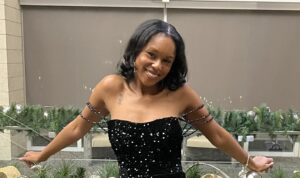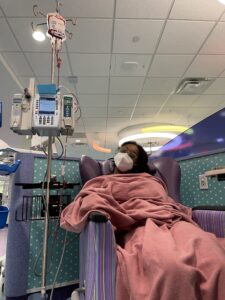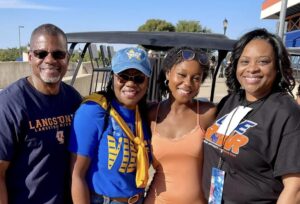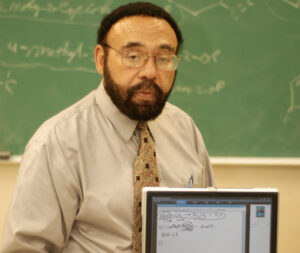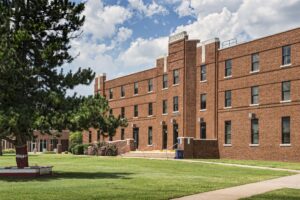
From Theory to Practice: Langston University Celebrates 25th Annual Research Day
(This story was originally published in ‘E Roar | Vol. 2 Issue 4 in June 2025)
By Jet Turner, Assistant Director of Communications
Langston University held its 25th Annual Research Day on April 18, 2025. Research Day includes various disciplines, majors and students. Whether you are a biology or chemistry student, psychology student or even a computer science student, you are welcome to participate in Research Day.
Research Day aims to help students understand the practical applications of their learning. It shows students how their knowledge can serve society and provides an opportunity to demonstrate their problem solving and articulation skills. It also allows students to build their resumes, prepare for internships and graduate school applications, among many other skills.
“It’s the value added,” said Dr. John K. Coleman, Interim Dean of the College of Arts and Sciences. “Once you get a culture where students (are presenting their research), you look at the student and you just see the product. Now they are starting to learn why they’re learning these theories and why they learn these concepts, and then what you can actually do with it and how you can help society. You’re here to learn, but you leave to serve. So how do you use what you’re learning? This is the part that teaches you how you use what you’re learning to serve society.”
Dr. Lindsay Davis, associate professor of chemistry, participated in the 13th Research Day when she was a student at LU.
Despite her fear and hesitation to present her research, she was well prepared and supported.
“Ultimately, Research Day gave me the confidence that I needed to pursue graduate school and to make these presentations a norm for me,” Dr. Davis said. “I was so scared of public speaking, and now it’s easy.
“So, Research Day definitely helps with their communication skills. But most importantly, I think it allows them to be a scientist, to communicate through research and to really achieve their goals.”
This year over 20 students participated in Research Day.
Josiah Grayson – Selection of Undergraduate Degree Major Among College Students
Senior, Computer Science Major
Josiah Grayson’s research explored the psychological and social factors influencing how college students, especially those at Historically Black Colleges and Universities (HBCUs), choose their academic majors.
Grayson’s studies revealed personal interest is the most important factor when a prospective student selects a major, which contradicts his hypothesis that financial considerations would be at the forefront of their decision-making process.
Grayson highlights that student interests are often “shaped by what they have been exposed to,” meaning individuals are more likely to pursue careers and majors they have seen modeled in their communities. For Black students specifically, this means decisions are “shaped by survival, legacy and representation.”
“Institutional culture and climate impacts persistence,” Grayson said. “What goes on at the university and then specifically in the department, how they teach the information, how they work with the students. Is there tutoring? These things highly impact whether or not somebody is actually going to finish their degree.”
Financial status, according to Grayson, still plays a significant role in a student’s decision in what major they select, even if it isn’t the primary driving force. Grayson notes that students from a lower socioeconomic status tend to be more risk-averse, often choosing a “more stable” career path, while students from higher socioeconomic backgrounds have more flexibility to pursue less conventional majors, if they so choose.
Kimbree Layton – Studying the Relationship Between Mental Health, Emotional Well-Being and Academic Well-Being Among College Athletes
Senior, Psychology Major
Kimbree Layton conducted a comprehensive study examining the relationship between mental health, emotional well-being and academic well-being among collegiate athletes at Langston University. Her research focused specifically on anxiety, depression and stress levels among student athletes.
The study employed a multi-scale survey approach, utilizing four different psychological assessment tools. Layton was able to collect data from 15 of Langston University’s student athletes, all of whom were female.
Findings revealed that Langston University student athletes generally demonstrated positive mental health indicators, showing no significant signs of depression, anxiety or stress.
“(The student athletes) think highly of professional help and seeking it when it is necessary,” Layton said.
Layton’s research highlighted several critical factors influencing student athlete mental health, including “the importance of their relationships” with coaches, professors and family. Modern student athletes must overcome a tough emotional landscape, and many challenge the stigma that they should always be “very mentally tough” and not show emotions.
While the study provides valuable insights, Layton recognized limitations in her research, including the small sample size and the use of somewhat dated psychological assessment scales. She recommended future research should “examine what relationships between scales and demographics” exist and potentially explore the impact of teammates on mental health, a dimension not fully explored in this current study.
Reginald M. Archibald II – Artificial Intelligence Biases in Healthcare
Senior, Computer Science Major
Reginald Archibald II explored the critical issue of artificial intelligence (AI) bias in healthcare, highlighting how AI models can perpetuate systemic inequalities.
Archibald’s research uncovered six types of bias in healthcare AI models: implicit, selection, measurement, confounding, temporal and algorithm bias.
An example pointed to in this research is the dermatology AI tool developed by Stanford University, which was trained predominantly on images of lighter-skinned individuals. This could have a significant negative impact on patients who have a darker skin complexation.
“When you go in and they’re trying to detect for skin cancer, oftentimes they’re not able to find it, and they might (misdiagnose) you,” Archibald said.
Several other real-world scenarios demonstrate the potential harm of biased AI. During the COVID-19 pandemic, pulse oximeters were found to miss conditions in Black patients three times more often than in other races. Another study revealed an AI algorithm that based healthcare decisions on costs that systematically undervalued Black patients’ health needs.
To address these critical issues, Archibald proposes multiple solutions. These include conducting bias audits before AI deployment, training healthcare professionals on AI decision-making processes and incorporating synthetic data to improve representation.
He emphasizes the importance of diversity in AI development, stating that diverse team members can provide “ethical background knowledge about their race, their gender, their age group and their economic status.”

